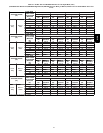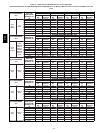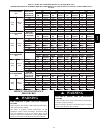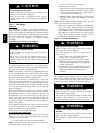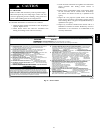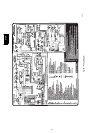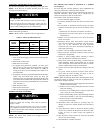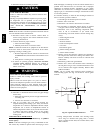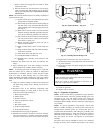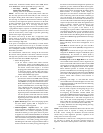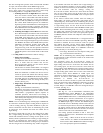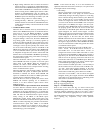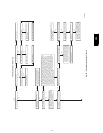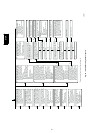
52
control CPU, transformer TRAN, inducer motor IDM, blower
motor BLWM, hot--surface igniter HSI, and gas valve GV.
1. Two --Stage Heating (Adaptive mode) with
Single--Stage Thermostat
(See Fig. 24 or 33 for thermostat connections)
NOTE: The low--heat only switch (LHT) selects either the
low--heat only operation mode when ON, (see item 2. below) or
the adaptive heating mode when OFF in response to a call for
heat. (See Fig. 34.) When the W2 thermostat terminal is energized
it will always cause high--heat operation when the R to W circuit
is closed, regardless of the setting of the low--heat only switch.
This furnace can operate as a two--stage furnace with a
single--stage thermostat because the furnace control CPU includes
a programmed adaptive sequence of controlled operation, which
selects low--heat or high--heat operation. This selection is based
upon the stored history of the length of previous gas--heating
periods of the single--stage thermostat.
The furnace will start up in either low-- or high--heat. If the
furnace starts up in low--heat, the control CPU determines the
low--heat on--time (from 0 to 16 minutes) which is permitted
before switching to high--heat.
If the power is interrupted, the stored history is erased and the
control CPU will select low--heat for up to 16 minutes and then
switch to high--heat, as long as the thermostat continues to call for
heat. Subsequent selection is based on stored history of the
thermostat cycle times.
The wall thermostat “calls for heat”, closing the R to W circuit.
The furnace control performs a self--check, verifies the low--heat
and high--heat pressure switch contacts LPS and HPS are open,
and starts the inducer motor IDM in high--speed.
a. Inducer Prepurge Period
(1.) If the furnace control CPU selects low--heat
operation the inducer motor IDM comes up to
speed, the low--heat pressure switch LPS closes, and
the furnace control CPU begins a 15--second
prepurge period.After thelow--heat pressure switch
re--closes the furnace control CPU will begin a
15--second prepurge period, and continue to run the
inducer motor IDM at high--speed.
(2.) If the furnace control CPU selects high--heat
operation, the inducer motor IDM remains running
at high--speed, and the high--heat pressure switch
relay HPSR is de--energized to close the NC contact.
When sufficient pressure is available the high--heat
pressure switch HPS closes, and the high--heat gas
valve solenoid GV--HI is energized. The furnace
control CPU begins a 15--second prepurge period
after the low--heat pressure switch LPS closes. If the
high--heat pressure switch HPS fails to close and the
low--heat pressure switch LPS closes, the furnace
will operate at low--heat gas flow rate until the
high--heat pressure switch closes for a maximum of
2 minutes after ignition.
b. Igniter Warm--Up--At the end of the prepurge period,
the (Hot Surface Igniter) HSI is energized for a
17--second igniter warm--up period.
c. Trial--for--Ignition Sequence--When the igniter
warm--up period is completed the main gas valve relay
contacts GVR--1 and --2 close to energize the gas valve
solenoid GV--M, the gas valve opens, and 24 vac power
is supplied for a field--installed humidifier at the HUM
terminal. The gasvalvesolenoid GV--M permitsgas flow
to theburnerswhere itis ignited by theHSI. Five sec after
the GVR closes, a 2--sec flame proving period begins.
The HSI igniter will remain energized until the flame is
sensed or until the 2--sec flame proving period begins. If
the furnace control CPU selects high--heat operation, the
high--heat gas valve solenoid GV--HI is also energized.
d. Flame--Proving--When the burner flame is proved at the
flame--proving sensor electrode FSE, the inducer motor
IDM switches to low--speed unless running at
high--speed, and the furnace control CPU begins the
blower--ON delay period and continues to hold the gas
valve GV--M open. If the burner flame is not proved
within two seconds, the control CPU will close the gas
valve GV--M, and the control CPU will repeat the ignition
sequence for up to three more Trials--For--Ignition before
going to Ignition-- Lockout. Lockout will be reset
automatically after three hours, by momentarily
interrupting 115 vac power to the furnace, or by
interrupting 24 vac power atSEC1 or SEC2 to the furnace
control CPU (not at W/W1, G, R, etc.). If flame isproved
when flame should not be present, the furnace control
CPU will lock out of Gas--Heating mode and operate the
inducer motorIDM onhigh speed until flameisno longer
proved.
e. Blower--ON Delay--If the burner flame is proven the
blower--ON delay for low--heat and high--heat are as
follows:
Low-- Heat--45 seconds after the gas valve GV--M is
energized the blower motor (BLWM) is energized at LO
HEAT speed.
High--Heat--25 seconds after the gas valve GV--M is
energized the BLWM is energized at HI HEAT speed.
Simultaneously, the electronic air cleaner (EAC--1)
terminal is energized and remains energized aslong asthe
BLWM is energized.
f. Switching from Low--to High --Heat--If the furnace
control CPU switches from low--heat to high--heat, the
furnace control CPU will switch the inducer motor IDM
speed from low to high. The high--heat pressure switch
relay HPSR is de--energized to close the NC contact.
When sufficient pressure is available the high--heat
pressure switch HPS closes, and the high--heat gas valve
solenoid GV--HI is energized. The blower motor BLWM
will switch to HI HEAT speed five seconds after the
furnace control CPU switches from low--heat to
high--heat.
g. Switching from High-- to Low--Heat--The furnace
control CPU will not switch from high--heat to low--heat
while thethermostat R--to--W circuit is closed when using
a singlestage thermostat.
h. Blower--OFF Delay--When the thermostat is satisfied, the
R to W circuit is opened, de--energizing the gas valve
GV--M, stopping gas flow to the burners, and
de--energizing the humidifier terminal HUM. The
inducer motor IDM will remain energized for a 5--second
post--purge period. The blower motor BLWM and air
cleaner terminal EAC--1 will remain energized for 90,
120, 150, or 180 seconds (depending on selection at
blower--OFF delay switches). The furnace control CPU
is factory--set for a 120--second blower--OFF delay.
2. Two--Stage Thermostat and Two--Stage Heating (See Fig.
32 for thermostat connections)
NOTE: In this mode the LHT must be ON to select the low--heat
only operation mode in response to closing the thermostat
R--to--W1 circuit. Closing the thermostat R--to--W1--and--W2
circuits always causes high--heat operation, regardless of the
setting of the low--heat--only switch.
The wall thermostat “calls for heat”, closing the R--to--W1 circuit
for low--heat or closing the R--to--W1 and--W2 circuits for
high--heat. The furnace control performs a self--check, verifies the
312A



